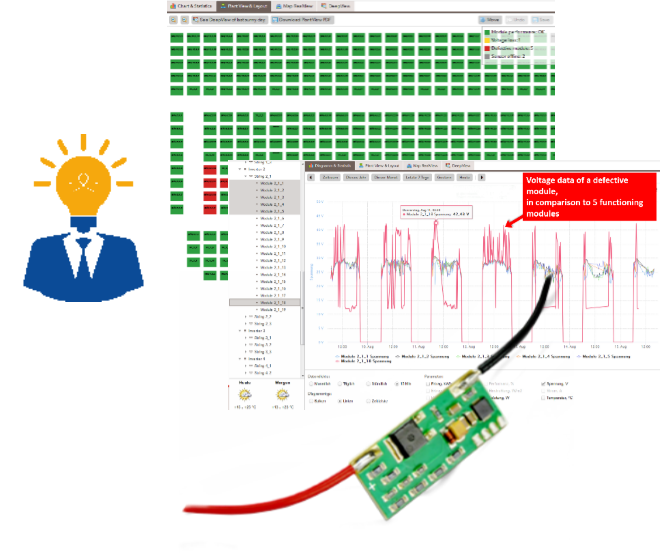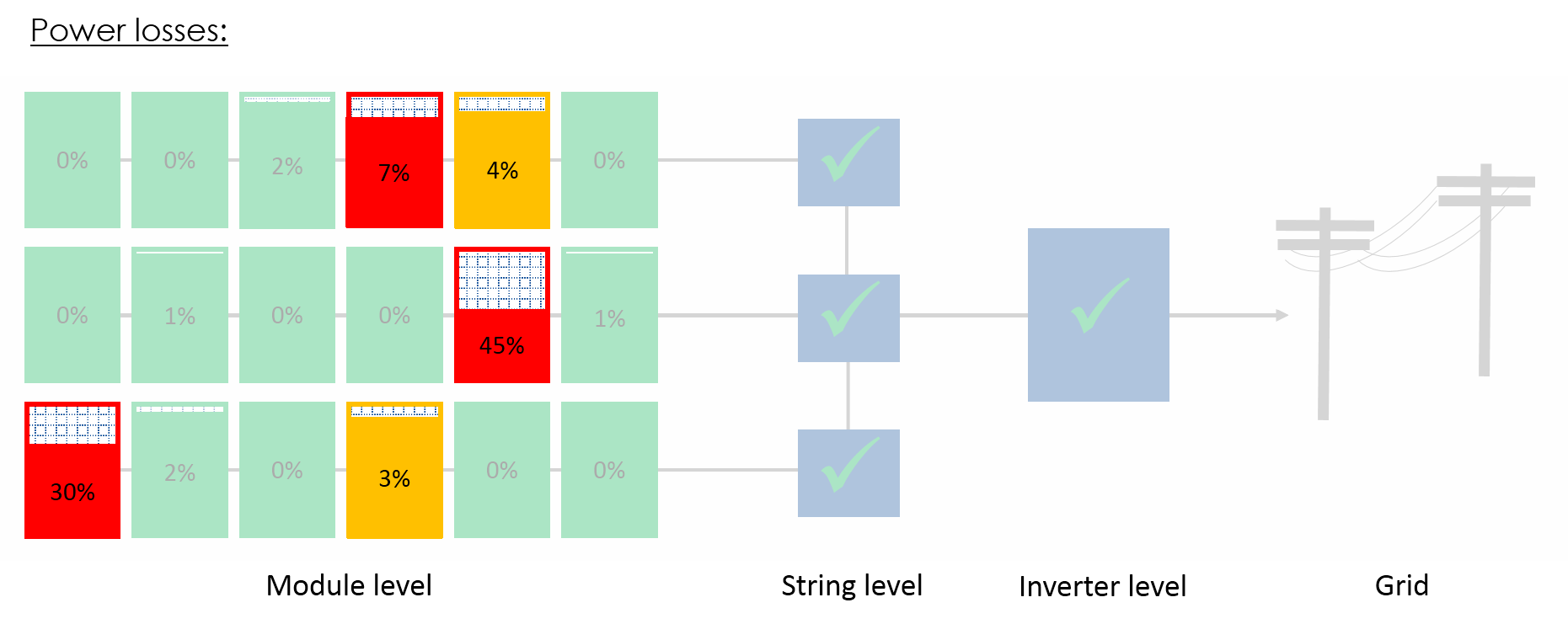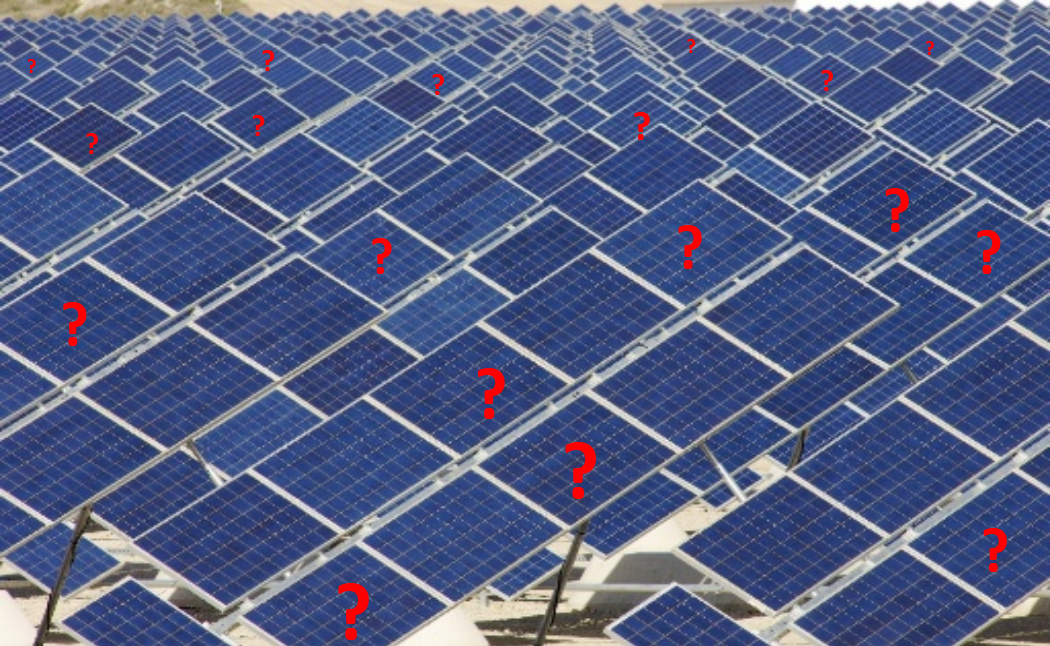Can Module Digitalization Revolutionize PV O&M?
Nearly everything is digitalized these days - except solar modules. Considering all of the developments in the PV industry, it would seem that their time has come. A statistical evaluation of the Bavarian Center for Applied Energy Research (ZAE Bayern) found that nearly 8 percent of all modules in the field have issues, and 4 percent of all strings1. These errors were exposed through extensive IR inspections, not usual monitoring.
So how is a PV plant usually monitored?
In general, a PV plant is monitored at inverter level, and sometimes at string level. Monitoring at inverter level gives information about the amount of power production and downtimes, and, if available (through additional irradiation sensors), can give information about the performance of the plant. But is the power produced the maximum the plant can achieve? And if not, why not? Where are the errors? Error-search is time-consuming and expensive, and requires the right equipment and expertise.  Depending on the size and location of the plant, searching for the error can be a herculean task. In some cases, therefore, operators may be reluctant to organize a service - accepting the losses may seem a less costly route. Even when the modules are still under warranty, the search process can be deterrent. However, if ignored, they will grow and lead to additional collateral failures. String monitoring also has its faults. While it gives a more compartmentalized insight into the plant, it cannot detect specific problems. Another study of ZAE Bayern showed that the current of a defective module is pulled up to the current values of the functioning modules in that string2. So string monitoring will not disclose an error within that string, as the current will not deviate, and gives no indication about an error.
Depending on the size and location of the plant, searching for the error can be a herculean task. In some cases, therefore, operators may be reluctant to organize a service - accepting the losses may seem a less costly route. Even when the modules are still under warranty, the search process can be deterrent. However, if ignored, they will grow and lead to additional collateral failures. String monitoring also has its faults. While it gives a more compartmentalized insight into the plant, it cannot detect specific problems. Another study of ZAE Bayern showed that the current of a defective module is pulled up to the current values of the functioning modules in that string2. So string monitoring will not disclose an error within that string, as the current will not deviate, and gives no indication about an error.
How about a list of exact power losses of individual modules?
Only constant module measurements, and analysis of these data, can address the problem of faulty modules on an operational day-to-day basis, without the need of frequent IR inspections. Measuring the data of each module, and analyzing them by artificial intelligence, enables a complete different O&M. With real-time monitoring remotely from one's desk, the main O&M tasks shift from finding an error, to precisely defining when to service or exchange defective modules. When you know the exact power loss of each individual module, exchange services, warranty cases, and even linear warranty, can easily be settled.
Real-time module precise monitoring through digitalized modules shifts maintenance from preventive, to predictive. A comparative study demonstrated that IR imaging is not able to assert defects resulting in power losses of below 4 percent3. Yet highly precise measurements of even 1 percent are very valuable, as these allow predictive maintenance; evaluations of degradation processes over a long time span, such as PID, are clearly identifiable.
How can precise module monitoring be a solution?
Every module has a specific voltage line, which is quite consistent. Deviations of this line instantly point to errors. Measuring this line over the course of each day, and analyzing the data (including all historical information), leads to clear error detection and identification. Temperature significantly affects module performance as well. By measuring each module's temperature, it's possible to calculate each module's real power performance. Also knowing the exact real-time power loss of each module compared to a reference module, enables the setting of parameters regarding exchange of a module. For example, should the power drop by more than 3 percent within the warranty period, that module can instantly be exchanged. This is even more important in terms of a linear warranty.
 With digitalized modules, the information of every module - its power, voltage, and temperature - is available in real time. Sophisticated analysis enables management of the entire plant, even for non-technicians. Financial, commercial, and technical evaluations can be produced at the push of a button - literally. With a list of exact power losses of each module, O&M can be structured and standardized.
With digitalized modules, the information of every module - its power, voltage, and temperature - is available in real time. Sophisticated analysis enables management of the entire plant, even for non-technicians. Financial, commercial, and technical evaluations can be produced at the push of a button - literally. With a list of exact power losses of each module, O&M can be structured and standardized.
Digitalization is the future, and the PV industry is finally catching up.
Ingmar Kruse founded his first company in 1983. He studied Business Administration in Nuremberg, and Computer Science in Atlanta, and has devoted himself entirely to the development of new technologies and their market introduction. In 1996, he received a rare license from Apple for the production of Apple computers. In 1989, he introduced the first color scanner in the market, launched the first color management system "Color Storm" in 1993, and in 1997 developed the ColorProof Software, the first digital color simulation software. With SunSniffer he developed the first Operating System for solar modules.
Daniela Kramer is head of marketing and public relations for Sunsniffer.
SunSniffer | www.sunsniffer.de
2 www.sunsniffer.de/images/downloads/ZAE-Defect-Analysis-of-installed-PV-Modules_with-comment-v3.pdf
3 www.sciencedirect.com/science/article/pii/S1876610217339383
Volume: 2017 November/December










.png?r=4950)

